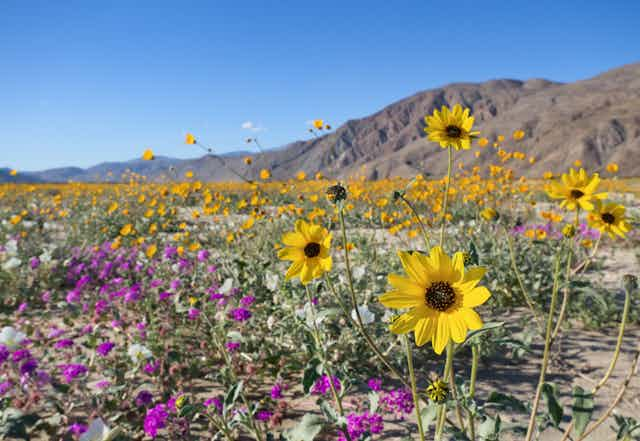Species that evolved far apart have been thrown together by worldwide transport, global warming, deforestation and farming. This is increasing the rate at which plant hybrids are being produced and these new species can dramatically affect local plants, animals and ecosystems.
We don’t know exactly how many new hybrids there are throughout the world but we do know humans are responsible for a good chunk of them. A third of the wild hybrids found in the British Isles, for instance, have one or more foreign parents. Those foreign plants were brought there, knowingly or unknowingly, by humans.
Ecosystems in emerging economies could be particularly at risk, where land use is changing rapidly and international trade is still accelerating, for example the Amazon rainforest or the mountains of south China which are among the world’s richest natural locations.
The problem with hybrids
New hybrids combine the characteristics of their parents and, in some cases, this can help them thrive as invasive species. Back in the late 19th century, a native grass along England’s southern coast mated with an introduced North American grass. The resulting “English cordgrass” has since spread around the world, helped by people who used it to stabilise sand dunes from Asia to Australia and back to North America. In some places, it has become a noxious invasive plant.
Hybrids can also damage local plants by serving as bridges to exchange genes between native and non-native species. The influx of foreign genes can lead to a sort of genetic “melting pot” where the where the identity of the native species is blurred beyond recognition. Some call this “extinction by mating”.
But it’s not all doom and gloom. Although the current rate is alarming, hybridisation is part of the natural world and has been slowly going on for millions of years. Many species of plants and animals hybridise naturally, and this exchange of genes between species could be behind of some of the most impressive examples of evolutionary change. The extraordinary diversity of the “cichlid” fish found in Africa’s great lakes is partly down to hybridisation, for instance, and research even suggests occasional hybridisation may boost diversity and trigger evolutionary change in the famous Darwin finches of the Galapagos.

Plants are naturally “promiscuous” and hybridisation between closely related species is common. It can produce unexpected characteristics. For instance, hybrid sunflowers that evolved after their parents came into contact thousands of years ago can thrive in droughts and salty soil, which allowed them to colonise America’s deserts.
New species take a long time to form and become established, of course, so it’s likely we won’t detect many of these human-induced hybrids for a while yet.
But there are exceptions. Some new hybrid species have a mutation which cases them to double the amount of DNA in their cells. Genome doubling, or polyploidisation, results in an immediately “obese” genome in which each copy of the hybrid DNA is duplicated. Duplication of the DNA material can occur in a single generation – and thus the formation of new species is instantaneous in evolutionary terms.
As polyploid plants carry twice as many chromosomes as their parents, they can no longer reproduce with either. The polyploid hybrid is thus its own biological species and unlike regular hybrids it cannot be easily “mated” into extinction.
Many common crops such as strawberries or potatoes are polyploids, but the process occurs in nature too. In fact, at least six new plant species have evolved in the past 200 years through hybridisation and genome doubling.

The most recent case is the “Scottish monkeyflower”, which was produced when non-native species from Chile and North America encountered each other in Britain. The hybrid of these two plants suffered a genome-doubling mutation, and a new species was formed. Curiously, the same hybrid appears to have evolved twice, entirely independently: once in southern Scotland and once in the Orkney Islands, ten miles off the country’s north coast.

It’s important to remember that hybridisation between native and introduced species isn’t necessarily bad for conservation. Gene transfer could help native plants deal with global change by giving them a broader genetic “arsenal” which they can use to evolve rapidly to keep up with climate change. Hybridisation with non-native species could then be a form of evolutionary rescue.
It remains to be seen whether all this hybridisation is good or bad news for global diversity. But one thing is certain. Humans have altered the biosphere to such an extent that there is no way back: the reshuffling of the world’s plants and animals cannot be undone – and hybrids are a natural consequence of these changes. Welcome to the new hybrid kingdom.

